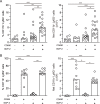Interference with glycosaminoglycan-chemokine interactions with a probe to alter leukocyte recruitment and inflammation in vivo
- PMID: 25093679
- PMCID: PMC4122422
- DOI: 10.1371/journal.pone.0104107
Interference with glycosaminoglycan-chemokine interactions with a probe to alter leukocyte recruitment and inflammation in vivo
Abstract
In vivo leukocyte recruitment is not fully understood and may result from interactions of chemokines with glycosaminoglycans/GAGs. We previously showed that chlorite-oxidized oxyamylose/COAM binds the neutrophil chemokine GCP-2/CXCL6. Here, mouse chemokine binding by COAM was studied systematically and binding affinities of chemokines to COAM versus GAGs were compared. COAM and heparan sulphate bound the mouse CXC chemokines KC/CXCL1, MIP-2/CXCL2, IP-10/CXCL10 and I-TAC/CXCL11 and the CC chemokine RANTES/CCL5 with affinities in the nanomolar range, whereas no binding interactions were observed for mouse MCP-1/CCL2, MIP-1α/CCL3 and MIP-1β/CCL4. The affinities of COAM-interacting chemokines were similar to or higher than those observed for heparan sulphate. Although COAM did not display chemotactic activity by itself, its co-administration with mouse GCP-2/CXCL6 and MIP-2/CXCL2 or its binding of endogenous chemokines resulted in fast and cooperative peritoneal neutrophil recruitment and in extravasation into the cremaster muscle in vivo. These local GAG mimetic features by COAM within tissues superseded systemic effects and were sufficient and applicable to reduce LPS-induced liver-specific neutrophil recruitment and activation. COAM mimics glycosaminoglycans and is a nontoxic probe for the study of leukocyte recruitment and inflammation in vivo.
Conflict of interest statement
Figures




Similar articles
-
Glycosaminoglycan mimicry by COAM reduces melanoma growth through chemokine induction and function.Int J Cancer. 2012 Aug 15;131(4):E425-36. doi: 10.1002/ijc.26465. Epub 2011 Nov 9. Int J Cancer. 2012. PMID: 21953247
-
Rescue from acute neuroinflammation by pharmacological chemokine-mediated deviation of leukocytes.J Neuroinflammation. 2012 Oct 25;9:243. doi: 10.1186/1742-2094-9-243. J Neuroinflammation. 2012. PMID: 23095573 Free PMC article.
-
The dependence of chemokine-glycosaminoglycan interactions on chemokine oligomerization.Glycobiology. 2016 Mar;26(3):312-26. doi: 10.1093/glycob/cwv100. Epub 2015 Nov 17. Glycobiology. 2016. PMID: 26582609 Free PMC article.
-
Targeting Chemokine-Glycosaminoglycan Interactions to Inhibit Inflammation.Front Immunol. 2020 Mar 31;11:483. doi: 10.3389/fimmu.2020.00483. eCollection 2020. Front Immunol. 2020. PMID: 32296423 Free PMC article. Review.
-
Glycosaminoglycan Interactions Fine-Tune Chemokine-Mediated Neutrophil Trafficking: Structural Insights and Molecular Mechanisms.J Histochem Cytochem. 2018 Apr;66(4):229-239. doi: 10.1369/0022155417739864. Epub 2018 Jan 1. J Histochem Cytochem. 2018. PMID: 29290145 Free PMC article. Review.
Cited by
-
The Controversial Role of LPS in Platelet Activation In Vitro.Int J Mol Sci. 2022 Sep 17;23(18):10900. doi: 10.3390/ijms231810900. Int J Mol Sci. 2022. PMID: 36142813 Free PMC article. Review.
-
Chlorite-Oxidized Oxyamylose (COAM) Has Antibacterial Activity and Positively Affects Skin Wound Healing.J Inflamm Res. 2022 Aug 30;15:4995-5008. doi: 10.2147/JIR.S375487. eCollection 2022. J Inflamm Res. 2022. PMID: 36065319 Free PMC article.
-
Serglycin in Quiescent and Proliferating Primary Endothelial Cells.PLoS One. 2015 Dec 22;10(12):e0145584. doi: 10.1371/journal.pone.0145584. eCollection 2015. PLoS One. 2015. PMID: 26694746 Free PMC article.
-
Chlorite oxidized oxyamylose differentially influences the microstructure of fibrin and self assembling peptide hydrogels as well as dental pulp stem cell behavior.Sci Rep. 2021 Mar 11;11(1):5687. doi: 10.1038/s41598-021-84405-4. Sci Rep. 2021. PMID: 33707502 Free PMC article.
-
The Heparanase Regulatory Network in Health and Disease.Int J Mol Sci. 2021 Oct 14;22(20):11096. doi: 10.3390/ijms222011096. Int J Mol Sci. 2021. PMID: 34681753 Free PMC article. Review.
References
-
- Rollins BJ (1997) Chemokines. Blood 90: 909–928. - PubMed
-
- Luster AD (1998) Chemokines–chemotactic cytokines that mediate inflammation. N Engl J Med 338: 436–445. - PubMed
-
- Zlotnik A, Yoshie O (2000) Chemokines: a new classification system and their role in immunity. Immunity 12: 121–127. - PubMed
-
- Moser B, Loetscher P (2001) Lymphocyte traffic control by chemokines. Nat Immunol 2: 123–128. - PubMed
-
- Wuyts A, Proost P, Van Damme J (1998) Interleukin-8 and other CXC chemokines. The Cytokine Handbook, 3rd Ed. Chapter 10. Ed. A. Thomson, New York Academic Press.
Publication types
MeSH terms
Substances
LinkOut - more resources
Full Text Sources
Other Literature Sources
Molecular Biology Databases
Miscellaneous

